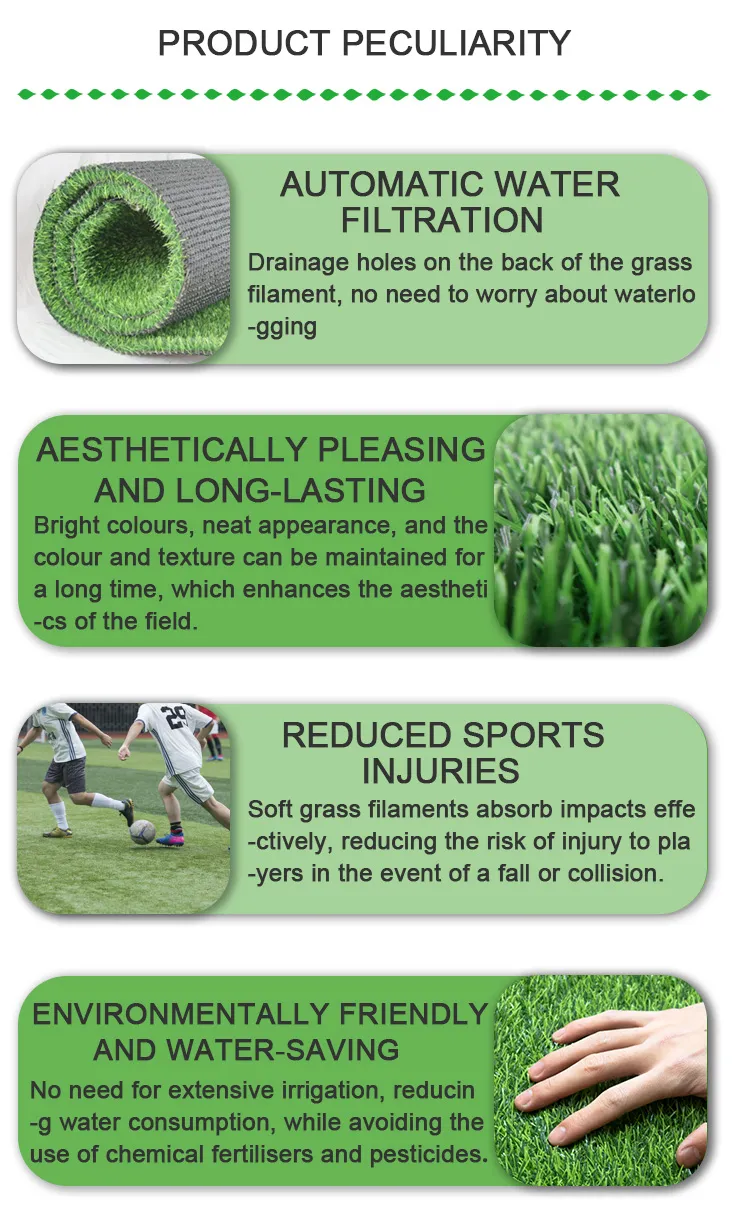
- Afrikaans
- Arabic
- Belarusian
- Bengali
- Czech
- Danish
- Dutch
- English
- Esperanto
- Estonian
- Finnish
- French
- German
- Greek
- Hindi
- Hungarian
- Icelandic
- Indonesian
- irish
- Italian
- Japanese
- kazakh
- Rwandese
- Korean
- Kyrgyz
- Lao
- Latin
- Latvian
- Malay
- Mongolian
- Myanmar
- Norwegian
- Persian
- Polish
- Portuguese
- Romanian
- Russian
- Serbian
- Spanish
- Swedish
- Tagalog
- Tajik
- Thai
- Turkish
- Turkmen
- Ukrainian
- Urdu
- Uighur
- Uzbek
- Vietnamese
Choosing the Best Synthetic Turf for Sports Fields and Athletic Facilities
Nov . 29, 2024 13:26 Back to list
The Rise of Synthetic Grass for Sports Fields
In recent years, the sporting world has witnessed a significant transformation with the increasing adoption of synthetic grass for sports fields. This innovative material has replaced traditional grass in many sports facilities, creating environments that are not only more durable but also safer and more versatile. As athletes and sports organizations continue to seek improvements in performance and maintenance, synthetic grass has emerged as a favorable alternative for various types of athletic activities.
Advantages of Synthetic Grass
One of the primary benefits of synthetic grass is its durability. Unlike natural grass, which can suffer from wear and tear due to heavy foot traffic, synthetic surfaces are designed to withstand the rigorous demands of different sports. This durability means that facilities can host events without the worry of damaging the playing surface, leading to a more consistent performance environment for athletes.
Additionally, synthetic grass requires considerably less maintenance compared to natural grass. Traditional grass fields need watering, mowing, fertilization, and pest control, all of which consume time, labor, and resources. In contrast, synthetic grass fields only require periodic cleaning and brushing, drastically reducing maintenance costs over time. This efficiency is particularly appealing to schools, sports clubs, and municipalities with limited budgets and resources.
Furthermore, synthetic grass offers improved playability and safety. The surfaces are engineered for shock absorption, reducing the risk of injuries such as sprains and fractures that can occur on harder surfaces. Enhanced drainage systems also ensure that synthetic fields can be used shortly after rain, eliminating issues related to muddy or uneven playing surfaces. This reliable performance allows athletes to train and compete under consistent conditions regardless of the weather.
Environmental Considerations
While the benefits of synthetic grass are clear, environmental concerns have also arisen. The production of synthetic grass typically involves plastic materials, which raises questions about sustainability and biodegradability. However, many manufacturers are addressing these concerns by creating eco-friendly options made from recycled materials or by developing systems for recycling used turf.
synthetic grass for sports field

Moreover, the water savings associated with synthetic grass are significant. In regions where water is a scarce resource, replacing natural grass with synthetic alternatives can lead to major reductions in water usage. This aspect is particularly crucial in areas that face drought, allowing communities to conserve water while still providing quality sports facilities.
A Diverse Application
Synthetic grass is not limited to one type of sport. Its versatility allows for its use in a wide range of athletic activities, including soccer, football, field hockey, and lacrosse. Each sport can benefit from customized turf systems designed to meet specific performance standards. For instance, a soccer field may have a different pile height and infill mixture than a football field to accommodate the unique demands of the game.
Moreover, synthetic grass is increasingly being used for recreational purposes, such as in parks and playgrounds. Its durability and safety features make it an excellent choice for children’s play areas, where injuries from falls can be minimized. The expansive range of uses for synthetic grass demonstrates its potential to enhance not only competitive sports but also community engagement and physical activity.
The Future of Synthetic Grass in Sports
As technology continues to advance, the future of synthetic grass in sports fields looks promising. Innovations in materials and manufacturing processes are leading to increasingly realistic and high-performance turf systems. These advancements will likely continue to improve the experience for athletes while addressing environmental concerns and sustainability challenges.
In conclusion, synthetic grass has become an integral part of the modern sports landscape. Its durability, low maintenance, safety, and versatility make it a compelling choice for sports fields across the globe. As the demands of athletes and the expectations of sports organizations evolve, synthetic grass is poised to play a key role in shaping the future of sports facilities, providing a reliable and sustainable solution for generations to come. The growing trend towards synthetic surfaces reflects not only a shift in material preference but also an evolving understanding of what it means to provide safe, efficient, and high-quality athletic environments.
-
The Benefits of Artificial Turf for Indoors
NewsJul.15,2025
-
How Artificial Grass Suppliers Ensure Quality Products
NewsJul.15,2025
-
Artificial Grass and Pets: A Space for Relaxation
NewsJul.08,2025
-
Balcony & Outdoor Decoration with Artificial Grass
NewsJul.08,2025
-
Best Indoor Artificial Grass for Home
NewsJul.07,2025
-
Best Pet Turf for Dogs: Safe & Durable Artificial Grass Options
NewsJul.07,2025
Products categories









